Congress establishes a federal policy for foreign-born citizens to become U.S. citizens. Citizenship is limited to “any alien, other than an alien enemy, being a free white person” of good character who has resided in the U.S. for at least two years.
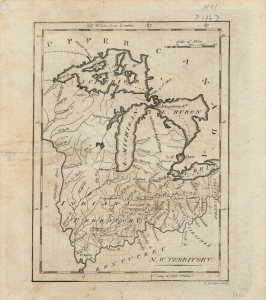
When Congress separates Ohio from the Northwest Territory in 1800, the rest of the territory becomes the Indiana Territory. French traders have been active in the area for over a century.
Credit: Indiana Historical Society View Source
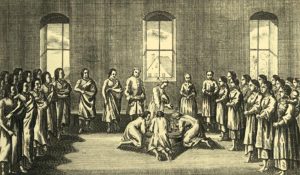
Moravian missionaries arrive at one of the settlements of the Delaware, near the Adena culture mounds and what becomes Anderson. The Moravian mission is to convert Indigenous Peoples to a Protestant version of Christianity. The mission lasts until September 1806.
Credit: Wikimedia Commons View Source
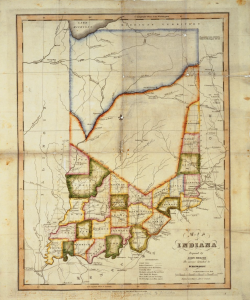
Indiana is admitted into the union as the 19th state. French, German, and Irish immigrants are all living in the area.
Credit: Indiana Historical Society View Source
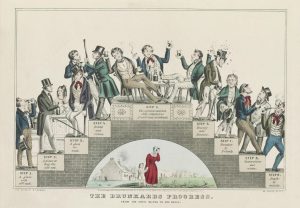
Started by Protestant groups, the union seeks to address what it considers to be the excessive use of alcohol. Many of its members are anti-immigrant and anti-Catholic, because these groups are viewed as primary abusers of alcohol.
Credit: Nathaniel Currier, Public domain, via Wikimedia Commons View Source
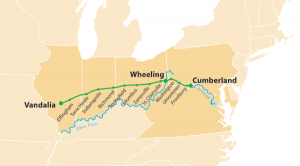
Construction on the National Road (now U.S. 40/Washington Street in Indianapolis) begins with Irish and German immigrants who flee economic pressures and religious concerns in Europe.
Credit: Public domain via Wikimedia Commons View Source
The law authorizes confiscation of land from Native Americans in Indiana and elsewhere and provides resources for their removal west of the Mississippi River. It forces most Native Americans in Central Indiana to leave their homelands, and white settlement increases rapidly. Many of these new white settlers are immigrants.
German immigrant William Wernweg, a contractor for the National Road bridges, establishes the brewery on the southside of Maryland near West Street with partner John L. Young. Germans dominate the brewing industry until Prohibition.
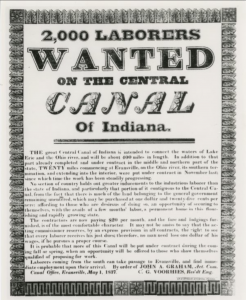
German and Irish immigrants, many of whom are Catholic, move to the city in sizeable numbers to work on the Central Canal. Their appearance raises concerns among residents who fear increased drinking and crime.
Credit: Bass Photo Co Collection, Indiana Historical Society View Source
Irish Catholics first convene for Mass at a tavern on West Washington Street. Father Vincent Bacquelin, a French itinerant priest, leads the group to form the forerunner of St. John Catholic Church. The Irish help to construct the parish’s church building, which opens in 1840.
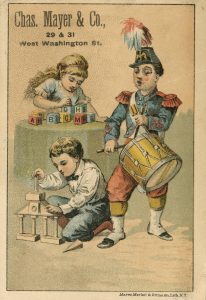
Mayer establishes a store that becomes known as Charles Mayer and Company in 1866. It gains a national reputation as a purveyor of fine gifts. Department store L. S. Ayres & Company purchases its inventory in 1955. Descendants of Mayer revive the company in 1992.
Credit: Indiana Historical Society View Source

A group of German immigrants organizes the Zion Evangelical Church. The building of the Evangelical Lutheran congregation, located at 32 West Ohio Street, is dedicated on May 18, 1845.
Credit: Bass Photo Co Collection, Indiana Historical Society View Source

A devastating fungus destroys Ireland’s potato crop, leading to starvation, poverty, and emigration. About 500,000 Irish immigrate to the U.S. during the 1840s. By 1850, the Irish comprise the second largest immigrant group in Marion County, making up 5.1 percent of the population. Foreign-born residents make up 15.6 percent of the county’s total population.
Credit: Public domain via Wikimedia Commons View Source
In October 1848, Julius Boetticher begins the Indiana Volksblatt (Indiana Peoples Paper), the first German-language newspaper in the city. The weekly paper is a conservative publication.
Failure to establish democracy causes thousands of Germans to immigrate to the U.S. Germans make up the largest immigrant group in Marion County by 1850, accounting for 9 percent of the population. Foreign-born residents make up 15.6 percent of the county’s total population.
Polish-born merchant Alexander Franco and English-born clerk Moses Woolf are the first Jewish people to arrive and settle in Indianapolis.
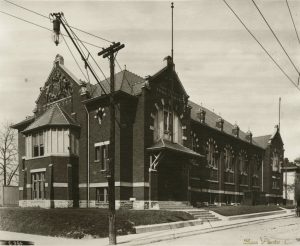
German immigrants establish the Indianapolis Turngemeinde, a German gymnastic society that promotes physical fitness, free thought, liberal politics, German language and culture, and social issues. By 1900, Indianapolis has three thriving Turnvereins: Socialer Turnverein, Independent Turnverein, and South Side Turnverein.
Credit: Bass Photo Co Collection, Indiana Historical Society View Source
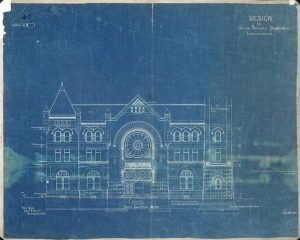
An immigrant from Derbyshire, England, Curzon designs the building, which is the first union station in the U.S. He also is architect for additions to Central State Hospital and Second Presbyterian Church at the corner of Pennsylvania and Vermont streets.
Credit: Indiana Historical Society View Source
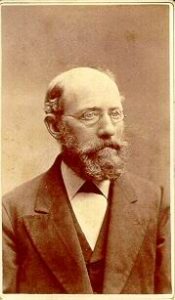
An immigrant from Münster, Westphalia, Germany, Vonnegut establishes the city’s major hardware store and plays an important role in the civic and intellectual activities of the German and wider Indianapolis community.
Credit: Indianapolis photograph studio (c.1885), Public domain, via Wikimedia CommonsView Source
Theodore Hielscher, a supporter of the 1848 German revolutions, founds the German-language newspaper as an uncompromising human rights voice that embraces free soil, abolition, and then the new Republican Party. The newspaper continues to be published until 1866.
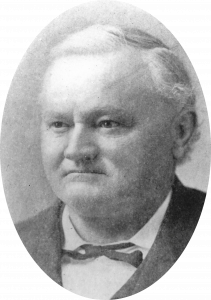
Born in the Kingdom of Hanover, Bohlen establishes the firm that later includes several of his descendants after it becomes D. A. Bohlen and Son in 1884. The company evolves with different partners and remains in business until 1991. The National Register of Historic Places includes more than 20 Bohlen projects.
Credit: Indiana University IndianapolisView Source
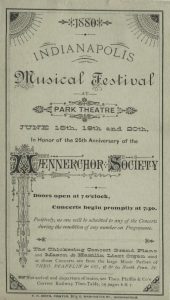
Seven young German American men who enjoy singing organize the Maennerchor. The group develops into an amateur music society of distinction, influencing the musical culture of Indianapolis.
Credit: Indiana University Indianapolis View Source

Although Lieber starts the business for stationery and bookbinding, he adds an art gallery for mounting exhibitions and plays a major role in the development of the visual arts in the city.
Credit: Indiana Historical Society View Source
German and Irish saloons resist state prohibition. When the Indiana General Assembly enacts a prohibition law, many German- and Irish-owned saloons organize and remain open in defiance of it. Saloonkeepers Roderick Beebe, a native of Vermont, and William Hermann, a German immigrant, are arrested. The incident culminates in the Beebe Temperance Case, in which the Indiana Supreme Court declares the prohibition law unconstitutional.
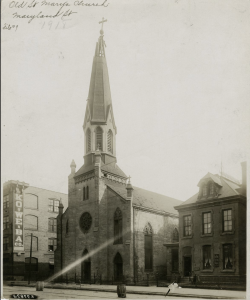
The city’s second Catholic parish is established as the spiritual home of German Catholics in the city. Sacred Heart, on the south side, follows as a second German-speaking parish in 1875.
Credit: Bass Photo Co Collection, Indiana Historical Society View Source
The City Council adopts a resolution allowing German pupils in local public schools to have instruction in their own language. School trustees oppose the measure, and it is never implemented.
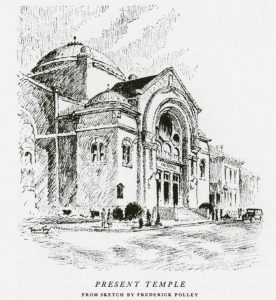
Fourteen German Jewish immigrants organize the Indianapolis Hebrew Congregation (IHC) which adheres to Reform Judaism, the most liberal of American Jewish religious movements. IHC’s first home, the Market Temple, is built at 435 East Market Street between 1865 and 1868.
Credit: Indiana Historical Society View Source
A group of German Americans in Indianapolis start the school to provide instruction in the German language and culture as well as in English.
German Jewish women immigrants organize the group that functions as a women’s auxiliary to the Indianapolis Hebrew Congregation, as well as a charitable society.
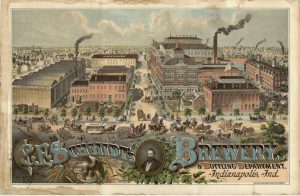
German immigrants Schmidt and Jaeger create the city’s first successful brewery, which gains popularity with its lager.
Credit: Indiana Historical Society View Source
Irish and Germans join the Union cause in large numbers. The Irish raise the 35th Regiment, using St. John’s parish school as a recruiting station. Governor Oliver P. Morton gives permission for prominent Germans to establish the 32nd (First German) Regiment.
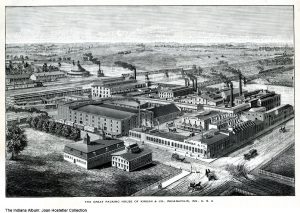
The Ireland-based pork packing company moves to Indianapolis and begins recruiting local Irish immigrants and imported Irish citizens.
Credit: The Indiana Album: Joan Hostetler Collection View Source
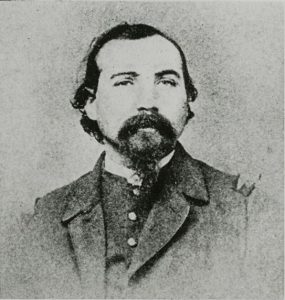
Knefler, a Jewish Hungarian immigrant, leads his regiment in battle at Perryville, Stones River, Chickamauga, Missionary Ridge, Atlanta, and Nashville. He musters out on June 7, 1865, as brevet brigadier general. He is one of the highest-ranking Civil War officers to come from Indiana.
Credit: Bass Photo Co Collection, Indiana Historical SocietyView Source

Caven serves five terms, longer than any other mayor until William H. Hudnut III (1976-1991).
Credit: Indiana Historical SocietyView Source
German Jewish immigrants organize the Indianapolis Hebrew Congregation (IHC) school to provide secular and religious education. By 1867, most Jewish children attend public schools, and the IHC institution becomes an afternoon school that instructs children in Hebrew customs and religious ceremonies.
German Jewish immigrants establish the first local B’nai Brith lodge to raise funds for and participate in the organization’s national projects.
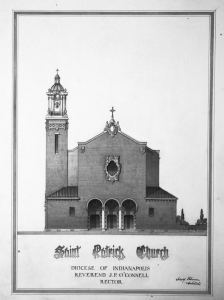
The Irish community that settles at the end of the Virginia Avenue streetcar line in Fountain Square establishes the church, which is renamed St. Patrick’s in 1870. Other Irish parishes include St. Joseph’s (1873), St. Bridget’s (1880), St. Francis de Sales (1881), and St. Anthony (1891).
Credit: Indiana University Indianapolis View Source
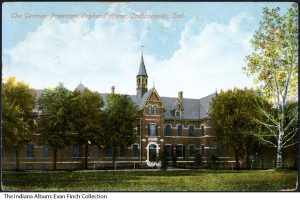
The German General Protestant Orphan Association (later Pleasant Run Children’s Home) is founded by the Germania Lodge Number 3 after visiting a similar home in Cincinnati, Ohio. The home cares for children orphaned by the Civil War.
Credit: The Indiana Album: Evan Finch Collection View Source
The Austro-Hungarian Compromise of 1867 creates a dual multi-ethnic empire, including Jews, Romanians, Slovenians, Slovaks, and others. Some ethnic minorities fleeing persecution settle in Indianapolis, including Jewish Hungarians, Romanians, and Slovenians.
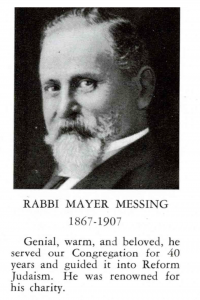
Born in Genivkowa in East Prussia, Messing serves as senior rabbi of IHC for 40 years. He is the first Jewish religious leader to participate actively in the civic life of the city.
Credit: Indiana State Library View Source
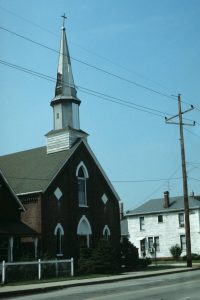
Forty-two Danish immigrants begin what may be the nation’s first Danish Lutheran congregation on the city’s south side, at 701 East McCarty Street. The congregation, later known as First Trinity Lutheran Church, moves to 5321 E. 42nd Street in 1952. The original building is now home to the Church of Christ Apostolic Faith.
Credit: Indiana University Indianapolis View Source
The amendment grants citizenship to all persons “born or naturalized in the United States,” including formerly enslaved people.
Negotiated during the first U.S. mission to China, the treaty allows for mostly unrestricted Chinese immigration to the U.S. Early Chinese residents of Indianapolis include a laundry owner, Wah Lee, who settles here around 1873; and E. Lung, owner of a laundry on Massachusetts Avenue, who arrives in 1879.
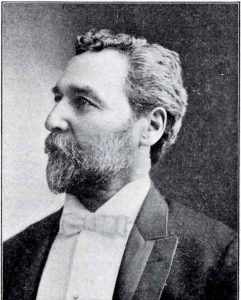
Kahn becomes the first Jewish resident to take a seat on the Common Council and serves for eight years, until 1881.
Credit: Indiana State Library View Source
The Indiana General Assembly authorizes German language instruction in schools if parents petition for it.
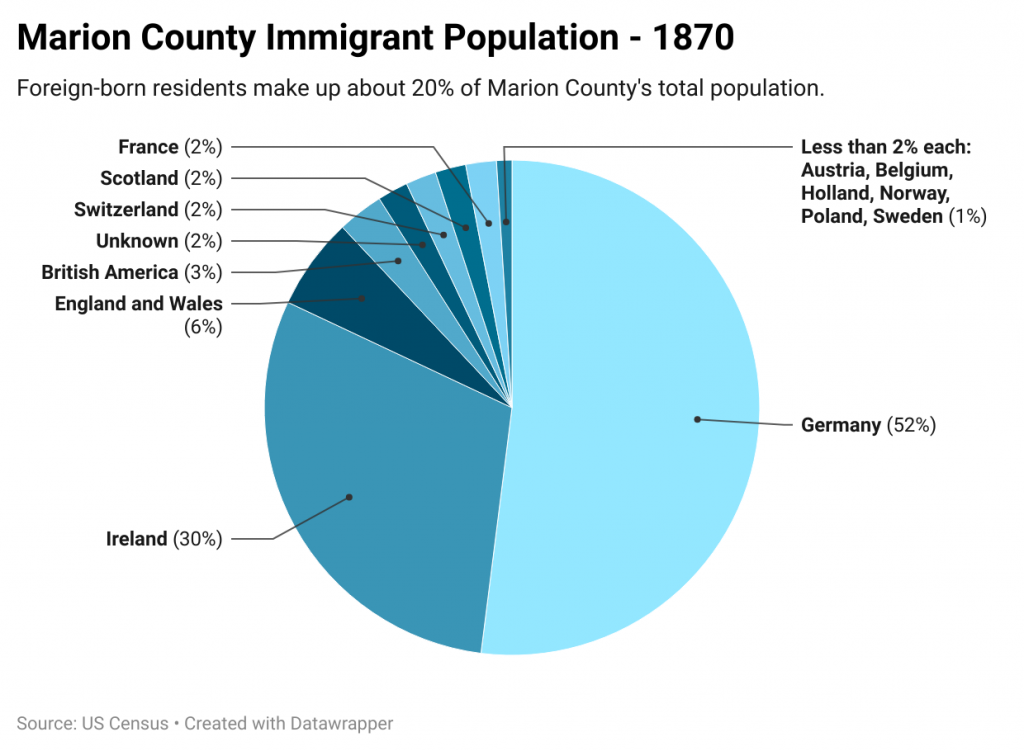
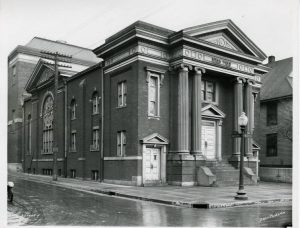
Jewish immigrants from Poland establish Chevro Bene Jacob (later Sharah Tefilla) on the south side of downtown Indianapolis as one of the earliest Jewish Orthodox synagogues in the city. The congregation merges with Bnai’ Torah in 1966. In 1992, Shaarey Tefilla, which traces its roots to the original congregation, forms.
Credit: Bass Photo Co Collection, Indiana Historical Society View Source
The organization provides “mutual support in sickness and distress” and advances the principles of Irish nationality.
The act grants naturalization rights to “all aliens of African nativity and to persons of African descent” but leaves the naturalization of other nonwhites uncertain.
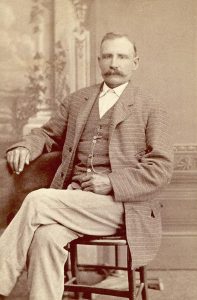
Peter Lawson, a Swedish immigrant, founds the north side suburb. His general store and post office stand near the town’s rail station, sawmill, blacksmith shop, and grocery.
Credit: Public domain via Wikimedia Commons View Source
Prussian Chancellor Otto von Bismarck unites the German states to form the German Empire under Protestant Prussian rule. Catholics from southern German states immigrate to the U.S. seeking religious freedom.
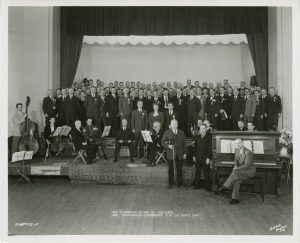
The merger of the male singing sections of two German secret fraternal organizations, the Druiden Lodge and the Rothmaenner (“Red Men”) creates the Indianapolis Liederkranz.
Credit: Bass Photo Co Collection, Indiana Historical Society View Source
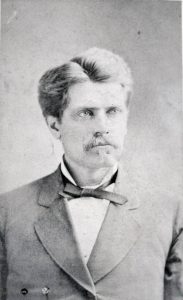
Emmerich, a native of Koblenz, Germany, joins the IPS faculty at Indianapolis High School at the invitation of Superintendent Abraham C. Shortridge. In 1895, he becomes the first principal of the Industrial Training School, one of the first of its kind in the U.S. The school is named Emmerich Manual High School in 1916.
Credit: Indiana Historical SocietyView Source
German, Irish, and British immigrants live in the area and are predominantly workers on the “Bee Line” railroad. The 1880 census reports that 40 percent of Martindale’s population is foreign-born or first-generation immigrant.
This act, also known as the Page Act, establishes immigration as an exclusively federal responsibility. It prohibits the importation of Asian contract laborers, any Asian woman who would engage in prostitution, and all people considered to be convicts in their own countries.
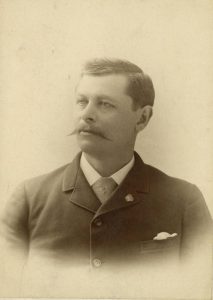
German immigrant William P. Jungclaus, who comes to Indianapolis in 1871, founds the building construction company, first known as Jungclaus & Schumacher, which is responsible for constructing many of the city’s historic buildings. Now known as Jungclaus-Campbell Company, it is the oldest building general contractor in Indianapolis and one of the oldest in the U.S.
Credit: Jungclaus-Campbell Co. View Source
Civil unrest breaks out between members of the Irish community, African Americans, and policemen over rumors that emerge about African Americans being turned away from the polls during a special election for city councilman.

More than four million immigrants, primarily from southern Italy, Sicily, and Sardinia, flee grinding poverty between 1880 and 1924. Italian immigrants to Indianapolis, mostly from Sicily, settle in what is now known as the Holy Rosary-Danish Church neighborhood, comprising 90 percent of the area’s population by 1910.
Jewish immigrants organize the first Hungarian association in the city, probably as a benevolent society and to establish public worship. The Hungarian Jüdische Bruder Verein, which sponsors social events and provides sick benefits to its members, follows in the mid-1880s.
The assassination of Czar Alexander II provokes new harsh anti-Jewish decrees and a wave of pogroms that lead to mass Jewish immigration to the U.S. Russian Jewish immigrants arrive in Indianapolis and settle on the south side.
The German Schützen Verein/Indianapolis Target Shooting Association establishes the park along West 21st Street between Fall Creek and Sugar Grove Avenue. It reorganizes as German Park in 1893.
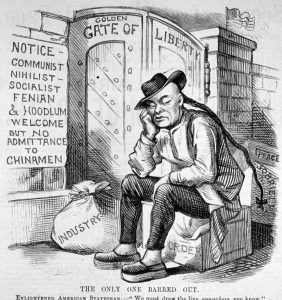
Branded as racially inferior and as a threat to American society, Chinese immigrants are denied citizenship, and Chinese laborers are banned from entry in the United States for 10 years. This law also authorizes the deportation of unauthorized Chinese immigrants. The measure is renewed in 1892 (Geary Act) and in 1904 (Extension of the Chinese Exclusion Act). Although the law is repealed in 1943, strict national origins quotas remain in place. Few Chinese immigrants settle in Indianapolis until after 1965.
Credit: Frank Leslie\'s illustrated newspaper, vol. 54 (1882 April 1), p. 96., Public domain, via Wikimedia Commons View Source

Members of the Bible society from St. Paul and Trinity Lutheran churches establish the Evangelische Lutherische Waisenhaus Gesellschaft, an asylum for orphans and aged people.
Credit: The Indiana Album: Joan Hostetler Collection View Source
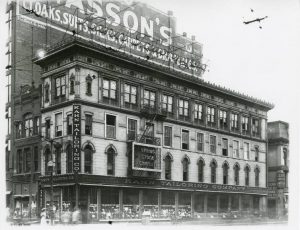
Henry Kahn, the son of Alsatian Jewish immigrants, opens a small tailor shop at 14 East Washington Street. Kahn Tailoring becomes a principal manufacturer of uniforms for the U.S. military during World Wars I and II.
Credit: W.H. Bass Photo Company Collection, Indiana Historical Society View Source
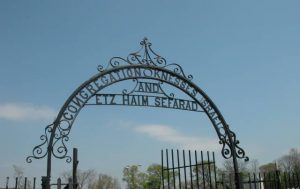
Jewish immigrants from Russia establish the third Orthodox immigrant synagogue, Knesses Israel. The congregation first resides on Merrill Street near where Lucas Oil Stadium now stands and then at 1021 South Meridian Street. In 1966, the congregation merges with B’nai Torah at 6510 Hoover Road.
Credit: Indiana Department of Natural Resources, Division of Historic Preservation and Archaeology View Source
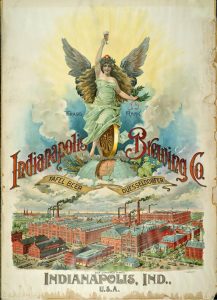
Three companies started by German immigrants form the Indianapolis Brewing Company: Schmidt & Jaeger Brewery (1859), Lieber Brewery (1863), and Casper Maus & Company (1865). It becomes known nationally and wins international prizes for its Dusseldorfer beer. With national Prohibition (1920), the company closes until repeal. Richard Lieber tries to resuscitate the Indianapolis brewing industry in 1934, without success.
Credit: Indiana Historical Society View Source

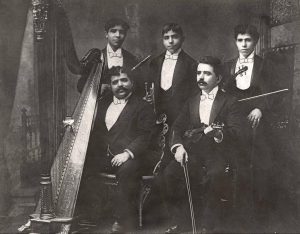
Guy and Domenico Montani, local Italian musicians, help organize the city’s first musicians’ union and the third such union in the country.
Credit: Indiana Historical Society View Source
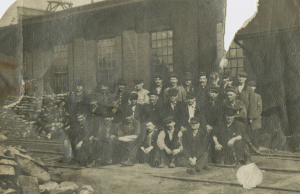
George Lambert, a Slovenian-born agent, begins recruiting Eastern European immigrants, particularly Slovenes, for the National Malleable Castings Company. The foundry pays the immigrants’ passage in return for a set period of employment.
Credit: Tamie Todd, Indiana Historical Society View Source
The German cultural and social center is constructed in two phases—the east wing in 1893-1894, the west wing in 1897-1898. It is renamed the Athenaeum because of anti-German sentiment during World War I.
The council advocates for human welfare through volunteerism and participation in education, service, and advocacy programs. Its members help the Jewish and immigrant community and the non-Jewish community.

Around 1894, a group of Syrian immigrants—three men, two women, and a boy arrived in Indianapolis and settled on Willard Street.
Credit: Indianapolis News View Source

Taggart, an Irish immigrant, defeats Republicans Preston C. Trusler and becomes mayor of Indianapolis. He serves three terms in office (1895-1901) which are marked by public improvements and fiscal efficiency.
Credit: Bass Photo Co Collection, Indiana Historical SocietyView Source
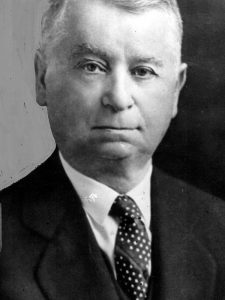
William H. Block Company, initially a small department store at 9 East Washington Street, becomes a major retailer in Indianapolis. It continues under the Block name until the Lazarus department store chain of Cincinnati takes over the company in 1988.
Credit: IndyStarView Source
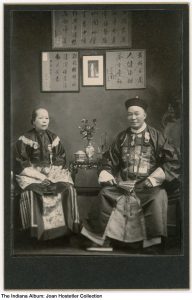
The Superior Court of New York issues Moy Kee’s first papers in 1880. He moves to Indianapolis in 1897, and, soon after, the Marion County Court grants him his second papers, thus conferring to him U.S. citizenship. He is the first naturalized Chinese person to vote in local elections.
Credit: The Indiana Album: Joan Hostetler Collection View Source
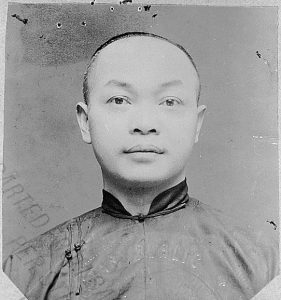
The Supreme Court case establishes the precedent that any person born in the U.S. is a citizen by birth regardless of race or parents’ status.
Credit: Public domain via Wikimedia Commons View Source
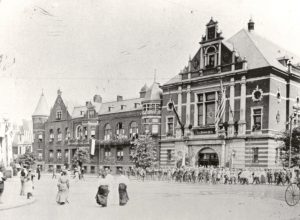
Herbert Lieber gives the dedication speech, lauding the structure as the “embodiment of the Americanizing process.” Designed by Bernard Vonnegut, the building becomes the center of German American culture.
Credit: Indiana Historical Society View Source
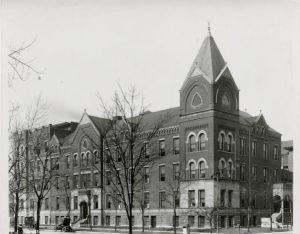
The German Evangelical Church organizes the Deaconess Hospital and first operates out of a home near the corner of Senate and Ohio streets. A new hospital facility opens next door at 200 North Senate in 1899. Unable to withstand the economic hardships of the Great Depression, it closes in 1935.
Credit: Bass Photo Co Collection, Indiana Historical Society View Source
Indianapolis is home to several German Support Societies that promote social connection and supply aid to German immigrants. The federation brings these societies together under their common goal of preserving German culture.

By 1906, the chapter has over 40 members, and they work to provide aid to Chinese immigrants affected by the San Francisco earthquake. The Indianapolis News estimates that Indianapolis has 60 permanent Chinese residents by 1910.
The St. Aloysius Lodge is the first Slovenian society established in the city. St. Joseph Lodge and the socialist-oriented Franc Preseren Lodge follow in 1905.
The office organizes in New York City to assist European Jews headed to the U.S. Indianapolis’ participation in its immigrant removal project leads to the formation of the Jewish Federation.

The new private German park on the south side becomes a center for activities that celebrate German culture, replacing the west side German Park, which closes in 1908.
Credit: The Indiana Album: Evan Finch Collection View Source

John Herron, an English immigrant, bequeaths $225,000 to the Art Association of Indianapolis in 1895 to build a museum and art school bearing his name.
Credit: Indiana Historical Society View Source
When Moy Kee’s wife joins him in Indianapolis, the Indianapolis News identifies her as the first-recorded female Chinese immigrant to the city.
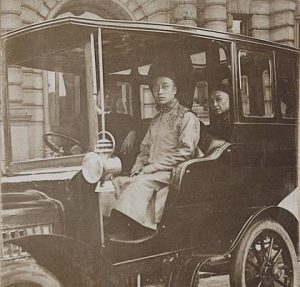
The local Chinese community participates in the 10-day visit of the Chinese prince, rumored heir to the Manchu throne, along with local dignitaries. Pu Lun names Chinese immigrant Moy Kee “Chinese mayor of Indianapolis.”
Credit: Library of Congress View Source
Russian antisemitism escalates as the tsarist regime of Nicholas II deteriorates. A new series of pogroms erupts at the same time as the 1905 Revolution, a precursor to the Bolshevik Revolution of 1917. With the assistance of the local Industrial Removal Office, immigrants from Belarus, Lithuania, and east-central Poland flee persecution and settle in Indianapolis on the south side.

Local Jewish leaders, primarily immigrants of German origin, establish the Jewish Federation to coordinate efforts to serve new Jewish immigrants from eastern Europe who were fleeing virulent anti-Semitism.
Credit: Indiana State Library View Source
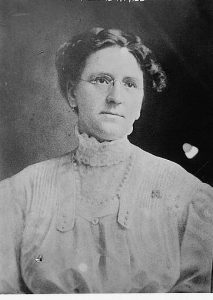
State Health Commissioner John N. Hurty appoints the East Prussian native to the role. In 1906, she is promoted to assistant state bacteriologist and becomes the first Indiana doctor to champion new treatments for rabies that greatly reduce mortality rates from the disease.
Credit: Library of CongressView Source
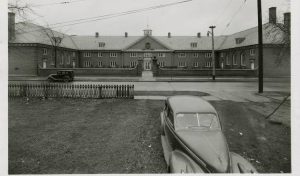
Butler University alumnae and urban missionaries Anna C. Stover and Edith D. Surbey create the center for the education and recreation of the immigrant working class in the Atlas neighborhood.
Credit: Bass Photo Co Collection, Indiana Historical Society View Source
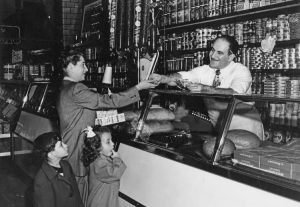
Louis Shapiro, who flees violent attacks on the Jewish community in Odessa in early 1906, sells kosher meats and groceries to the Jewish community living on the Indianapolis south side. He moves from 1032 S. Illinois Street to 808 S. Meridian Street in 1912 and then establishes the location as a delicatessen-cafeteria in the 1930s.
Credit: Indiana Historical Society View Source
The Slovene community, which previously worshipped at St. Patrick’s, opens the Holy Trinity Church in the Haughville neighborhood.

Established by Turners, the city’s German community welcomes the school to the Das Deutsche Haus, later known as the Athenaeum. It becomes part of the Indiana University extension in 1941 and the IUPUI School of Physical Education in 1973.
Credit: Bretzman Collection, Indiana Historical Society View Source

Born in Tokay, Hungary, Feuerlicht follows Mayer Messing as rabbi of IHC. He is active in civic life and becomes the most important Jewish opponent of the Ku Klux Klan during the 1920s.
Credit: The Bretzman Collection, Indiana Historical SocietyView Source
Mexican President Porfirio Diaz appoints Russell B. Harrison as vice consul of Mexico, representing Mexican citizens in Indianapolis and surrounding area.
East European Jewish immigrants establish an Indianapolis branch of the organization founded in New York City in 1892. Also known as the Arbeiter Ring, the club supports socialism, stresses the study of Yiddish culture and language, and assists members in the event of illness or death. It is an important institution for the city’s Jewish community into the early 1920s.

Bishop Francis Silas Chatard authorizes the formation of a new Catholic congregation, Holy Rosary, for the city’s Italian community.
Credit: Indiana Historical Society View Source
German immigrants associated with Zion Evangelical Church found the nonprofit German home for the aged of Indianapolis.
The social club encourages loyalty to the United States through citizenship instruction and developing an understanding between cultures. About 1,000 Romanians live in Indianapolis at this time.
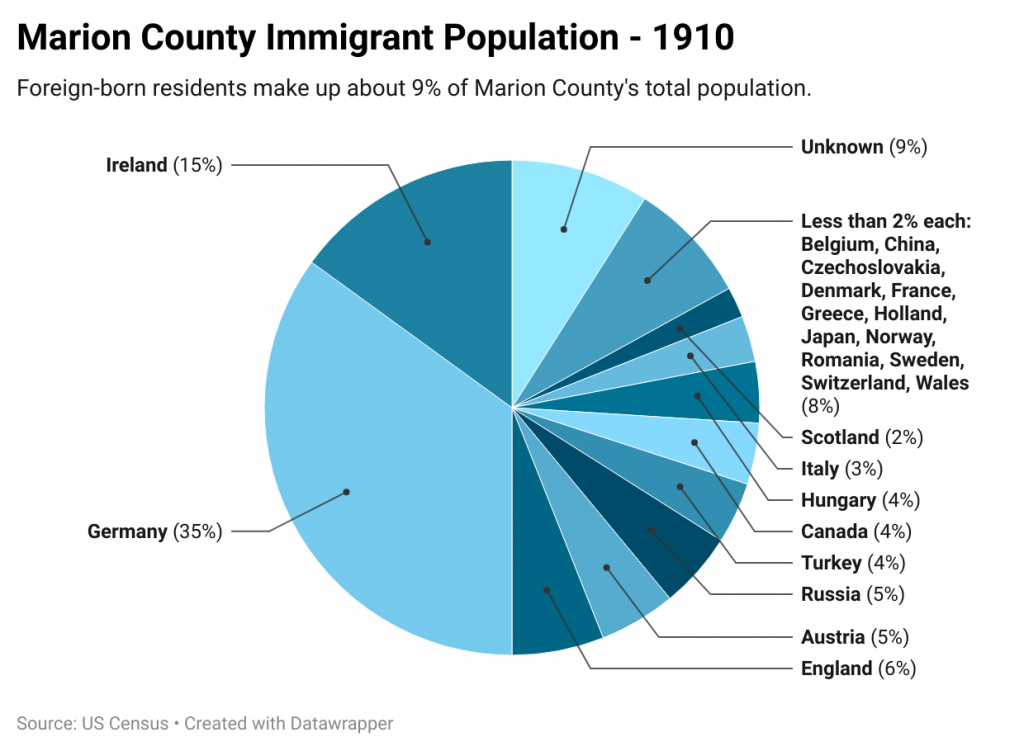
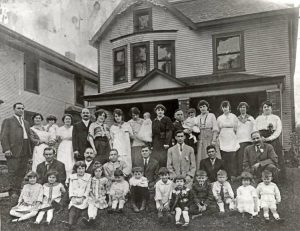
A small Greek community in Indianapolis forms the church, primarily young men from Tripoli and other central Peloponnesian villages.
Credit: Indiana Historical Society View Source
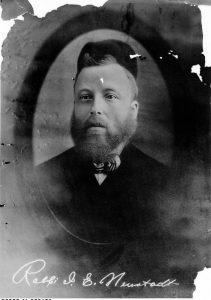
Lithuanian immigrant Rabbi Isaac Neustadt cultivates support for the establishment of the city’s central agency for Jewish education. The Bureau, composed of members from the Orthodox congregations (Sharah Tafilla, Ohev Zedeck, Knesses Israel, and the United Hebrew Congregation), opens its first community-wide school in 1911.
Credit: The Bretzman Collection, Indiana Historical Society View Source
Newly arrived Romanian immigrants form the SS. Constantine and Elena Orthodox Church. The congregation constructs its first building at 635 West Market Street.
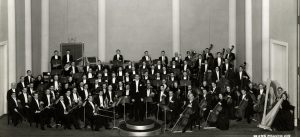
The orchestra, composed primarily of German musicians, produces seven seasons of concerts. It folds in November 1917 because of World War I, anti-German sentiment.
Credit: Indiana Historical Society View Source
The Immigrant’s Aid Association opens the settlement to serve simultaneously as a social service agency and an agency of Americanization and Protestant evangelism.
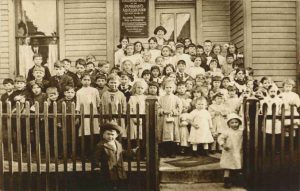
The association opens a settlement house at 617 West Pearl to provide social services and Americanize the immigrants.
Credit: Indianapolis Public Library View Source
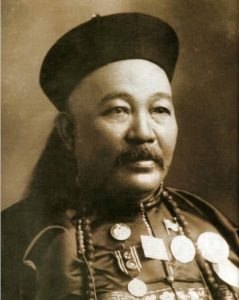
The Indianapolis News reports that the U.S. federal court has revoked Moy Kee’s citizenship, alleging it was granted erroneously after the Geary Act (the 1892 extension of the Chinese Exclusion Act) that explicitly forbids naturalization of Chinese individuals.
Credit: Indiana Historical Society View Source
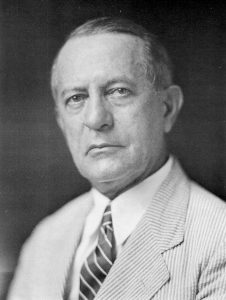
Efroymson, son of Polish Jewish immigrant and businessman Jacob Efroymson, serves as president of the major downtown retailer before purchasing Real Silk Hosiery Mills in 1932. He becomes an important leader in the Jewish community and makes significant contributions to Indianapolis philanthropy.
Credit: Indiana Historical SocietyView Source
Greece, Serbia, Montenegro, and Bulgaria declare war on the Ottoman Empire and defeat it. A second Balkan War breaks out on June 16, 1913. Ethnic cleansing marks the Balkan wars, leading to immigration from these countries to the U.S.

Members of the Sephardic community organize their own synagogue, Congregation Sepharad of Monastir, which is renamed Etz Chaim Congregation in 1919. The congregation moves into a former church at the corner of 64th Street and Hoover Road in 1963 and dedicates a new building at 6339 Hoover Road in 2005.
Credit: Indiana University Indianapolis View Source
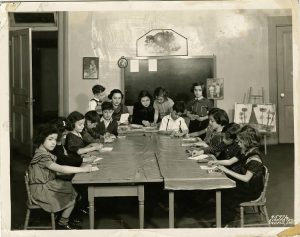
The Jewish Community Center is established as part of the Jewish Federation to provide social and educational programs for everyone of the faith but especially for newly arrived immigrants.
Credit: Indiana Jewish Historical Society Collection of the Indiana Historical Society View Source
The assassination of Archduke Franz Ferdinand, presumptive heir to the throne of Austria-Hungary, triggers the war that substantially slows the number of immigrants coming into the United States from European countries. German residents of Indianapolis face growing anti-German sentiment.
Macedonian and Bulgarian immigrants establish the St. Stephen Bulgarian Orthodox Church, which first resides on Blackford Street in downtown Indianapolis.
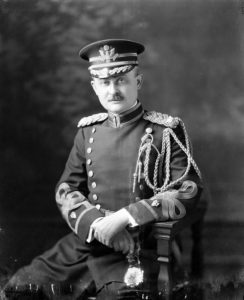
Lieber’s plan becomes the basis of the state Department of Conservation (now the Department of Natural Resources) and the state park system. He becomes the first director of the Department of Conservation in 1919 and continues in that position until 1933.
Credit: The Bretzman Collection, Indiana Historical SocietyView Source
The law creates a “barred zone” that extends from the Middle East to Southeast Asia from which no persons are allowed to enter the U.S. It also introduces a literacy test intended to reduce European immigration.
With U.S. entry into the war, anti-German rhetoric is fierce among local leaders, and German cultural institutions become targets of vandals. In response, these organizations anglicize or change their German names. German religious congregations begin performing services in English, and Das Deutsche Haus becomes the Athenaeum.
World War I, anti-German sentiment leads the Indianapolis Board of School Commissioners to ban German language study in local schools. In January 1919, the Indiana General Assembly bans German from all schools statewide.
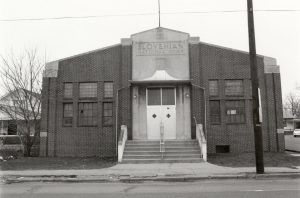
The National Home provides a social club and meeting place dedicated to preserving and passing along Slovenian traditions.
Credit: Indiana Historical Society View Source
The newspaper, the successor of the Indiana Volksblatt, closes, the victim of World War I, anti-German sentiment. Its demise ends publication of German-language daily newspapers in the city.
The U.S. Department of Labor and the Immigration and Naturalization Service authorize the importation of Mexican nationals as laborers in the name of war relief. This “guest worker program” brings Mexican workers all over Indiana.
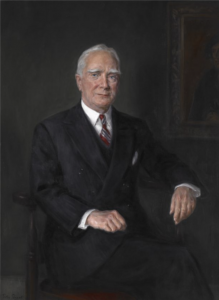
J. K. Lilly Sr. hires Clowes to oversee the pharmaceutical company’s research. He is instrumental in the discovery of insulin and its mass production, which revolutionizes the care of diabetes.
Credit: NewfieldsView Source
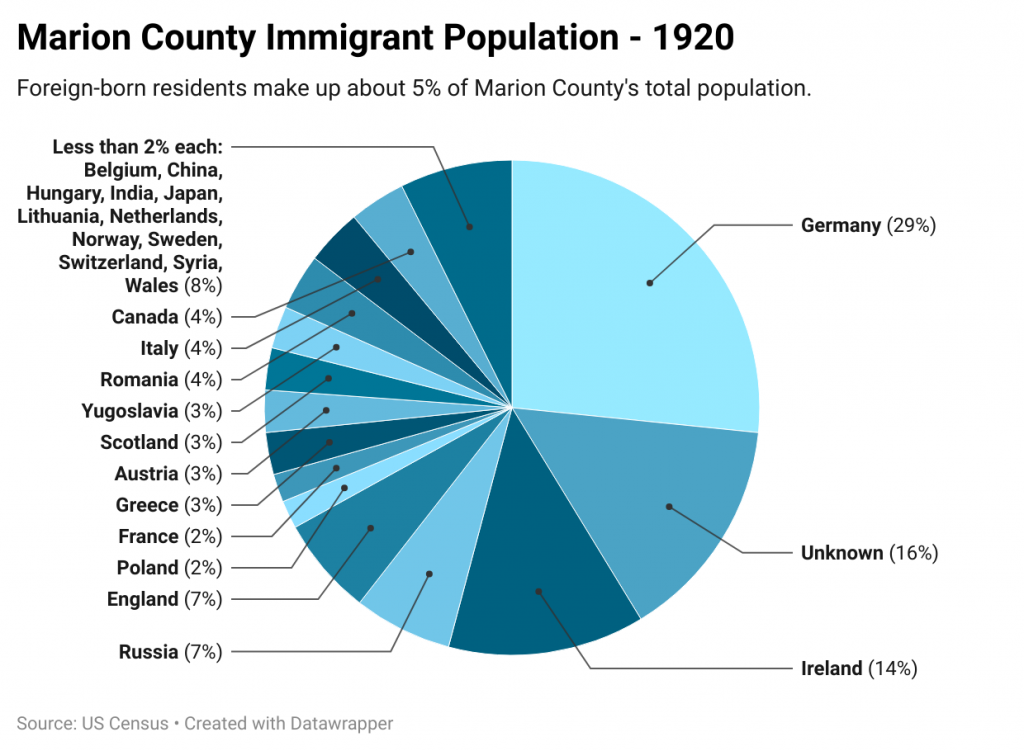
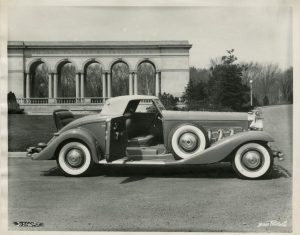
German immigrants Fred S. and August S. Duesenberg establish the company at Harding and Washington streets. At this location, they create one of the strongest automobile racing teams of the 1920s. A builder of high-end luxury cars, the automobile manufacturer does not survive the Great Depression, closing in 1937.
Credit: Bass Photo Co Collection, Indiana Historical Society View Source
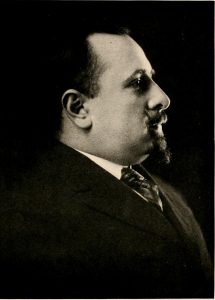
Born on an island in the Bay of Naples, Lapenta, a physician also known for his discovery of a serum to control hemorrhage, encourages the formation of Italian societies and lectures on Italian foreign and domestic policy. During World War II, he is detained as an “alien enemy” at Fort Benjamin Harrison.
Credit: Internet ArchiveView Source

The settlement forms through a consolidation of the Foreign House, established by the Immigrants’ Aid Association, and the Presbyterian Chapel, which works mainly with Bulgarian and Romanian immigrants.
Credit: Indiana University Indianapolis View Source
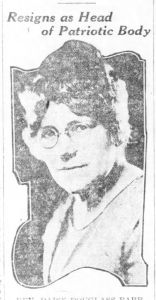
Barr openly calls for the campaign against Jewish business owners in Indianapolis, particularly naming William H. Block and his son as active targets of attack. The expressed intent of the Klan boycott is to drive every Jewish-owned business out of Indianapolis and the rest of the state. The Klan’s antisemitic boycott peaks in 1923 and lasts until 1925.
Credit: Indianapolis Times View Source
The law establishes a highly discriminatory quota system based on national origin as the primary means of determining immigrants’ admissibility to the U.S. until 1965.
The organization, headquartered in Indianapolis, is founded to boost the movement toward Macedonian independence (a Balkan country divided between Serbia and Bulgaria following WWI). The organization’s newspaper, the Macedonian Tribune, edited by Christo N. Nizamoff, is published between 1927 and 1971.

Queen Marie and other members of the royal family are honored with a downtown parade and a banquet at the Columbia Club, with Mayor John L. Duvall, Governor Ed Jackson, and other local dignitaries. In her public remarks made on the front steps of Central Library, Queen Marie calls for world peace and the elimination of “old hatreds.”
Credit: Public domain via Wikimedia Commons View Source

The church, associated with the Antiochian branch of Orthodox Christianity, opens as the first Arabic-speaking religious congregation in the city. It provides a place of worship for Syrian and Lebanese Orthodox Christian immigrants.
Credit: The Indiana Album: Joan Hostetler Collection View Source
The Jewish Welfare Fund forms to raise funds for local, national, and international Jewish communities. The fund provides relief to individual families as well as to Jewish agencies.
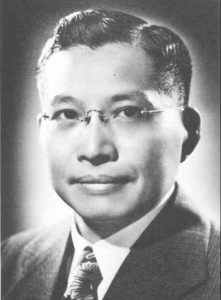
While at Lilly, Chen, a Chinese immigrant, accumulates many awards for his research and becomes known for his discoveries of ephedrine and a cyanide poison antidote.
Credit: Indiana University IndianapolisView Source
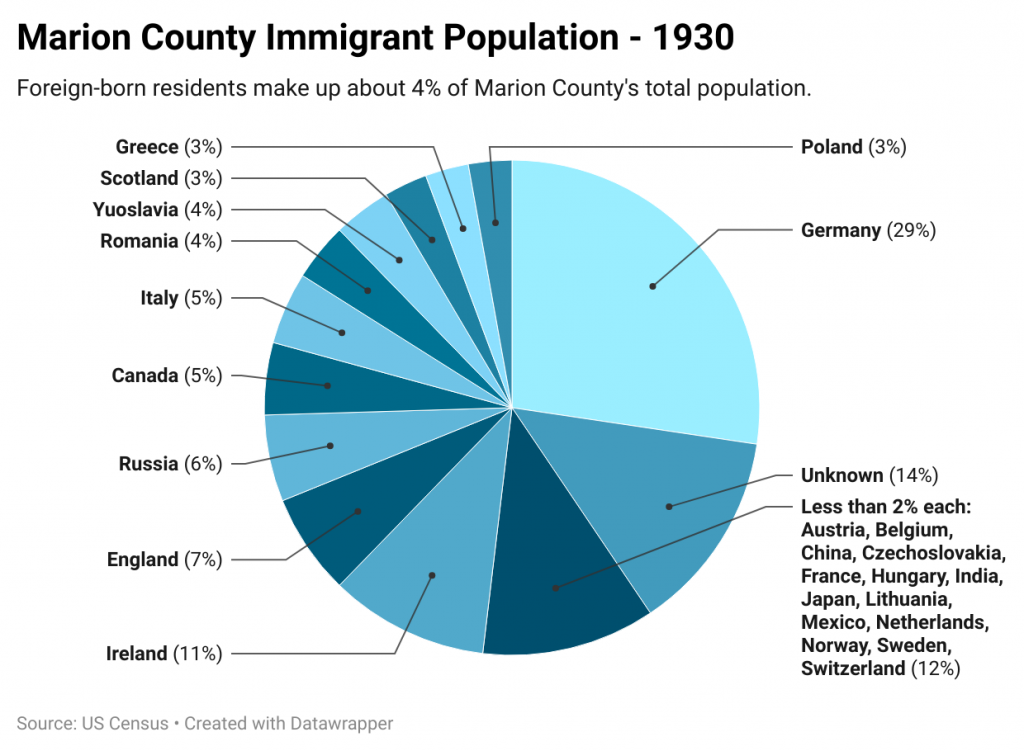
Italian immigrant Santora “Fred” Iozzo founds the Naples Grill. It becomes Iozzo’s Garden of Italy when it moves to the corner of Illinois and Washington streets and closes in 1940. Members of the Iozzo family revive the restaurant at 946 S. Meridian Street in 2009.
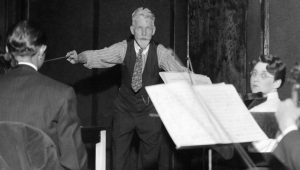
Ferdinand Schaefer, a German immigrant, begins the Indianapolis Symphony Orchestra and serves as the orchestra’s conductor until the 1937–1938 season. The first concert takes place at Shortridge High School.
Credit: IndyStar View Source
Serbian immigrants organize the home to celebrate their culture and sponsor national observances. The home provides food and clothing to Serbian prisoners of war during World War II.
Members of Holy Rosary Catholic parish create the event to celebrate Italian heritage, to raise funds, and increase church membership.
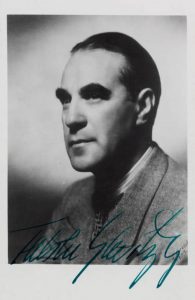
Born in Russia, Sevitzky reorganizes the orchestra, significantly increases its concert schedule, and raises it in national prominence. He also establishes the Indianapolis Symphonic Choir. He leads ISO until 1955.
Credit: Indiana Historical SocietyView Source
European Jewish refugees escaping Hitler’s regime begin arriving in Indianapolis. By 1941, about 250 are city residents.
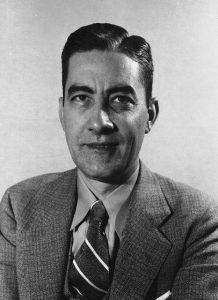
Mazzini creates the test that produces faster, cheaper, and more sensitive results for all stages of syphilis. Used by the U.S. Armed Forces during World War II, Mazzini gives patent rights to the Indiana University Foundation.
Credit: Indiana University IndianapolisView Source
The war begins with the German invasion of Poland. Those escaping Nazi persecution must navigate the strict national origins quota system to immigrate to the U.S.

The public affairs agency for the greater Indianapolis Jewish community is established to alert the broader community to the perils of Nazism and the Holocaust.
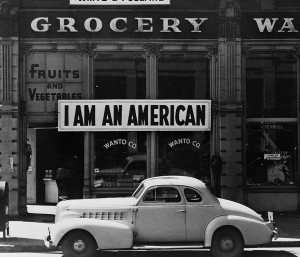
Japanese/Japanese Americans are asked to self-report to processing centers and are sent out to several War Relocation Centers (concentration camps) in western states.
Credit: Dorothea Lange, Library of Congress Prints and Photographs Division, Washington D.C. View Source
China’s importance to the U.S. government as its chief ally in the Pacific War against Japan leads U.S. Congress to repeal the Chinese Exclusion laws, placing China under the same restrictive immigration national quota system as European countries.
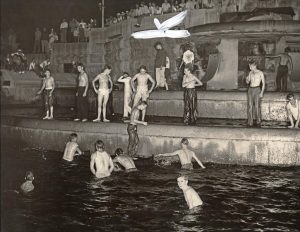
With the surrender of Germany and then Japan, refugees from across Europe immigrate to the U.S. in large numbers. During the Cold War that follows, the Soviet Union and its satellites in the communist Eastern Bloc establish strict controls over emigration, making immigration to the U.S. from these countries difficult.
Credit: Indiana Historical Society View Source
As the Japanese-American internment camps close, the Disciples of Christ, with its national headquarters in the city, help move internees to Indianapolis. Other local organizations, like the International Teamsters, also headquartered in Indianapolis, oppose Japanese resettlement.
The church’s leadership works to help World War II refugees and immigrants, leading to an influx of German, Lithuanian, Latvian, and Estonian immigrants to the city. The congregation plants the First Latvian Church in 1947 and for a time holds services in Estonian.
The Jewish Federation and Jewish Welfare Fund merge to form the Jewish Welfare Federation of Indianapolis. The new organization conducts annual fundraising campaigns to support local and national Jewish organizations.

Armenian immigrant Sarkes Tarzian owns the station, which begins broadcasting from Bloomington but moves to the Indianapolis south side. He also for a time owns WATI-AM.
Credit: IndyStarView Source
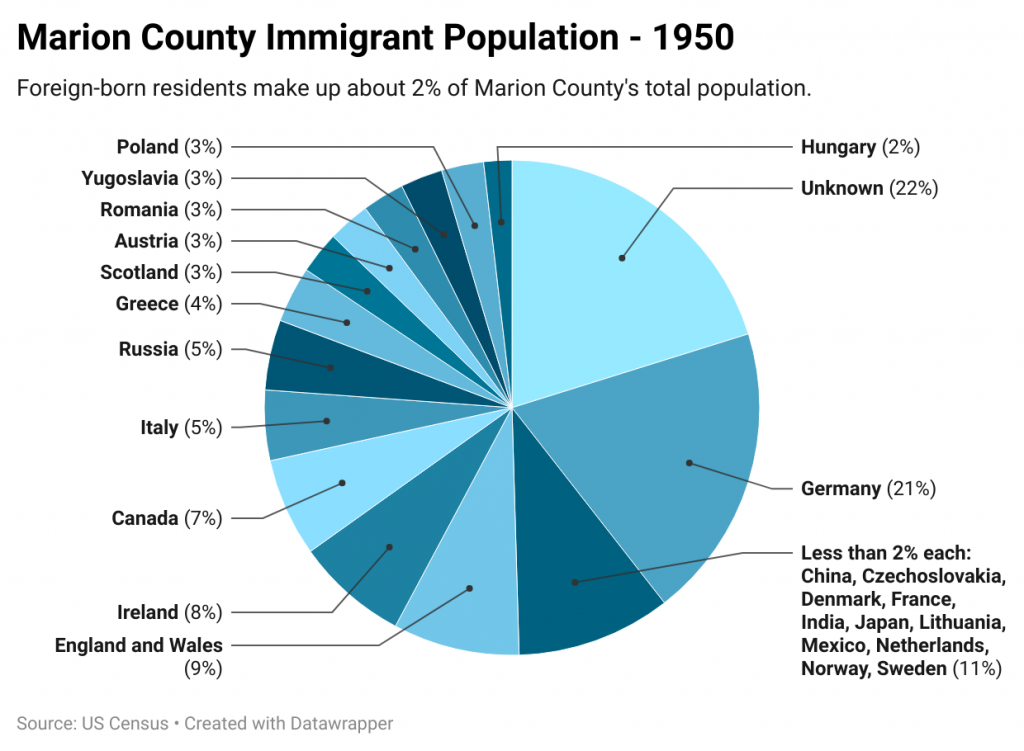
The first services of the St. Nicholas Serbian Orthodox Church are held at the Yugoslav National Home at 3626 West 16th Street.
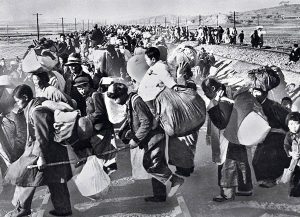
Koreans begin immigrating to the United States—particularly college students, orphans adopted by Americans, and wives of U.S. servicemen.
Credit: Public domain via Wikimedia Commons View Source
Chinese immigrants form a private social club at 134 E. New York Street. It remains in operation until 1958. A second Chinese Club is established at 314 Massachusetts Avenue in 1960.
The society supports anti-Soviet dissidents and organizes a variety of activities to foster understanding of Estonian culture.
Although the act, also known as the McCarran-Walter Act, formally removes race as a reason for exclusion, it expands immigration enforcement and offensive national origins quotas.
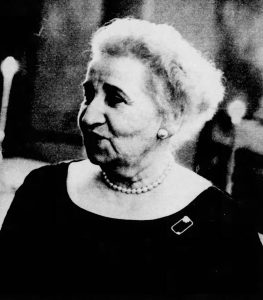
Born in Vienna, Austria, Goodman is the only woman to be the president of the Indianapolis Jewish Welfare Federation and the first woman to hold such a position in the U.S. She serves in the position until 1956.
Credit: IndyStarView Source
This relief act increases the allotment of special visas for individuals who come from communist countries in Eastern Europe but also from China and other countries in the Far East.
The club becomes the first formal Hispanic organization in the city.
Members of the society believe that “both the U.S. and Soviet governments are controlled by the same conspiratorial cabal of internationalists, greedy bankers, and corrupt politicians.” They oppose the United Nations and any cultural exchange with communist countries. Its headquarters move to Appleton, Wisconsin in the 1990s.
Following the fall of Fugencio Batista, Castro is named prime minister of Cuba. The U.S. recognizes his government, but relations break down quickly as Castro implements a communist regime and forges close ties with the Soviet Union. The United States cuts diplomatic ties with Cuba on January 3, 1961. By the end of 1962, 58,000 Cuban refugees enter the U.S. About 300 of them settle in Indianapolis.
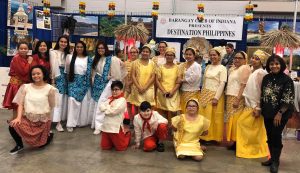
A group of the city’s Filipino immigrants establish the club to present programs and exhibit arts and crafts of the Philippines. Filipinos were not allowed to immigrate to the U.S. until 1946. They make up about 4 percent of the Indianapolis immigrant population in the last decades of the 20th century.
Credit: Barangay Club of Indiana View Source
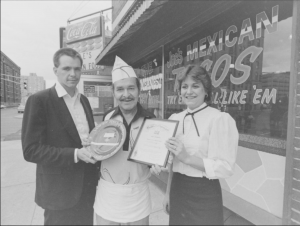
Mexican immigrant Jose Guadalupe Robles Rangel opens the first major downtown Mexican restaurant at 342 N. Illinois Street. It moves to 365 N. Illinois Street in 1983 and closes in 2019.
Credit: Indiana University Indianapolis View Source
The Free Cuban Association highlights the country’s culture and assists approximately 300 refugees who come to the city fleeing Fidel Castro’s communist regime during the early 1960s.
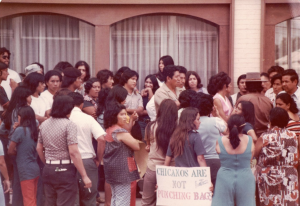
AMOS, located in Indianapolis, formalizes and unifies outreach and services for Indiana’s farmworker community. This is made possible through a federal grant from the Office of Economic Opportunity, through President Johnson’s War on Poverty initiative.
Credit: Velasquez Family, Indiana Historical Society View Source
This act, also known as the Hart-Cellar Act, significantly overhauls immigration policies by ending the restrictive policies based on ethnicity. The law also marks a turning point in Indianapolis, as its population becomes increasingly diverse following its passage.
As the Hispanic population in Indianapolis grows, St. Mary’s offers Sunday mass in Spanish. The parish becomes the center of the Archdiocesan Hispanic Apostolate, serving the needs of Spanish-speaking Catholics in the city.
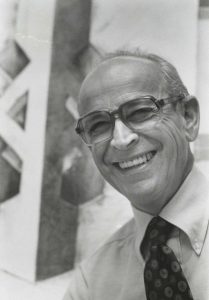
Neuss, an immigrant from Krakow, Poland, organizes the society, later known as Classical Music Indy, with a group of Eli Lilly researchers interested in providing a radio outlet for classical music. He becomes well-known as an arts supporter and as a voice on Fine Arts Society broadcasts.
Credit: Indianapolis Public LibraryView Source
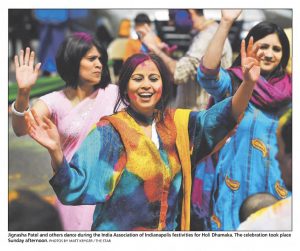
Established by the first 15 Indian families that come to the city, the India Association of Indianapolis promotes the cultural activities of India, fosters cultural exchange, and carries out educational and charitable activities. During the last decades of the 20th century, the Indian community grows to make up 6 percent of the Indianapolis immigrant population.
Credit: Matt Kryger, IndyStar View Source
The congregation is the first Sikh place of worship, or gurdwara, in Central Indiana. As other gurdwaras open across the city, it becomes the leader in Sikh community outreach efforts and commitment.
The Hispano-American Association, responding to the needs of the city’s Hispanic population, opens El Centro Hispano/The Hispanic Center with funding and support from the government and several churches.
Primarily a social organization, the society provides services to newly arrived immigrants. Koreans make up 5 percent of the immigrant population of Indianapolis in 1980.

The need for interpreters and translators for the North Atlantic Treaty Organization (NATO) Conference of Mayors in 1973 sparks the formation of the International Center. It later grows to provide services to local ethnic groups.
Credit: Indiana University Indianapolis View Source

Well-known as a community leader, Indian immigrant K. P. Singh establishes his business to market his hand-drawn drawings and prints of Indianapolis landmarks and of other buildings across the world. His artwork is featured in many public and private collections.
Credit: K.P. Singh, Indiana Historical Society View Source
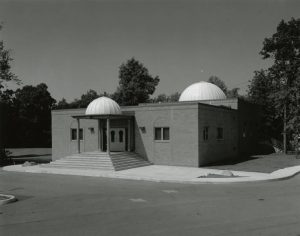
The first traditional Muslim congregation in Indianapolis, the group eventually builds Al-Fajr (Morning) mosque on Cold Spring Road.
Credit: Indiana Historical Society View Source
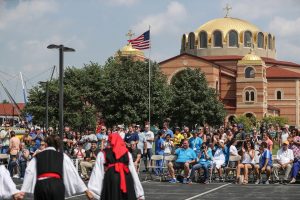
Holy Trinity parish begins hosting Indy GreekFest, a festival aimed at celebrating and sharing Hellenic heritage and the Orthodox Christian faith.
Credit: Jenna Watson, IndyStar View Source
The congregation, which began as a Bible study in 1968, worships at Meridian Street Methodist Church before moving to 56th and Broadway in 1982 and then to Carmel in 1999.
The association provides a sense of community to the Chinese in the city. It offers opportunities to showcase Chinese culture and heritage and to integrate with American society.
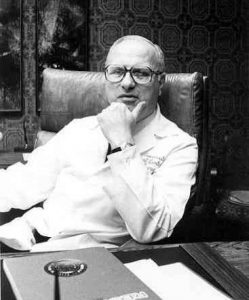
Beering, a German Jew who escapes the Nazi regime to come to the U.S. in 1948, becomes the youngest dean of the medical school. He serves as president of Purdue University from 1983 to 2000.
Credit: Indiana University Indianapolis View Source
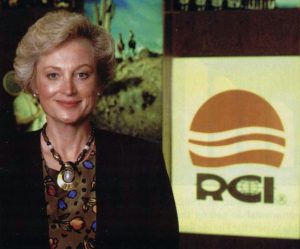
Born in Germany during World War II, DeHaan establishes the Indianapolis-based company that grows into an international enterprise with offices in 38 countries. She sells the company in 1996 to focus on her philanthropic endeavors, which include Christel House International and the Christel DeHaan Family Foundation.
Credit: Christel House View Source
Viktor Ziedonis, an immigrant from Daugavpils, Latvia, organizes the ensemble that becomes the orchestra in residence at the Palladium at the Center for the Performing Arts in 2011.
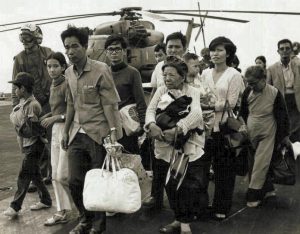
Signed one month after the fall of Saigon (April 30, 1975), the act grants refugees from communist regimes in Vietnam, Laos, and Cambodia special status to enter the country and establishes a domestic resettlement program. The Catholic Archdiocese of Indianapolis establishes Catholic Charities Indianapolis Refugee and Immigrant Services to resettle Vietnamese immigrants in 1975, and the Jewish Federation also settles Vietnamese refugees in the Indianapolis area in 1975-1976.
Credit: Public domain via Wikimedia Commons View Source
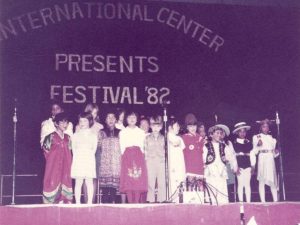
Under the management of the International Center, the festival begins as part of the nation’s bicentennial. It provides a platform for various ethnic groups to showcase their contributions to the culture, history, and economy of Indiana.
Credit: Jill Kramer, Indiana Historical Society View Source
When the Soviet Union’s policy regarding the emigration of Jews loosens from 1976 to 1979, the pace of emigration increases. The Jewish Federation of Indianapolis begins resettling Jewish Soviet immigrants in the mid-1970s.
The Polish Cultural Society of Indiana organizes to heighten awareness of the contributions of residents of Polish descent to Indianapolis and the state.

Japanese immigrants form these clubs to combat racial discrimination and to introduce Japanese culture to Indianapolis and the rest of the state.
Credit: Japanese American Citizens League View Source
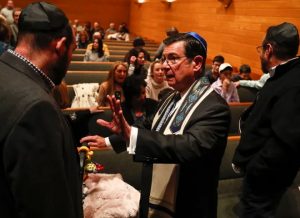
The Panamanian immigrant becomes the senior rabbi at the synagogue. He and his wife Sandy are the first married rabbinical couple in world history and become important civic leaders in the city.
Credit: Grace Hollars, IndyStar View Source

At age 37, the Japanese American is the youngest physician ever to reach this rank in the history of the medical school. He goes on to chair the department in 1983 and then works for Eli Lilly and Company, where he is executive vice president of science and technology.
Credit: Margaret R. Watanabe, Indiana Historical Society View Source
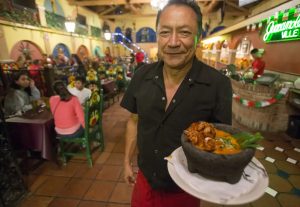
Mexican immigrant Javier Amezcua reopens the restaurant originally known as El Sol, marketing it as “the most authentic Mexican restaurant in town.” It closes in 2015.
Credit: Robert Scheer, IndyStar View Source
Immigrants from Andhra Pradesh, India, whose language and culture differ from the broader group of Hindi- and Gujarati-speaking Indians, organize the association to provide cultural education about Telugu drama, dance, and fashion.
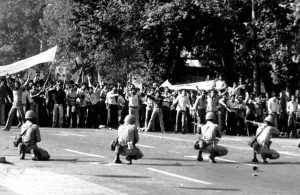
In an Islamic revolution that erupts in 1978, the last remnants of Shah Mohammad Reza’s government collapses, leading to the rise of the country’s Islamic Republic. The revolution results in roughly 330,000 Iranians immigrating to the United States as asylum seekers and political refugees.
Credit: Public domain via Wikimedia Commons View Source
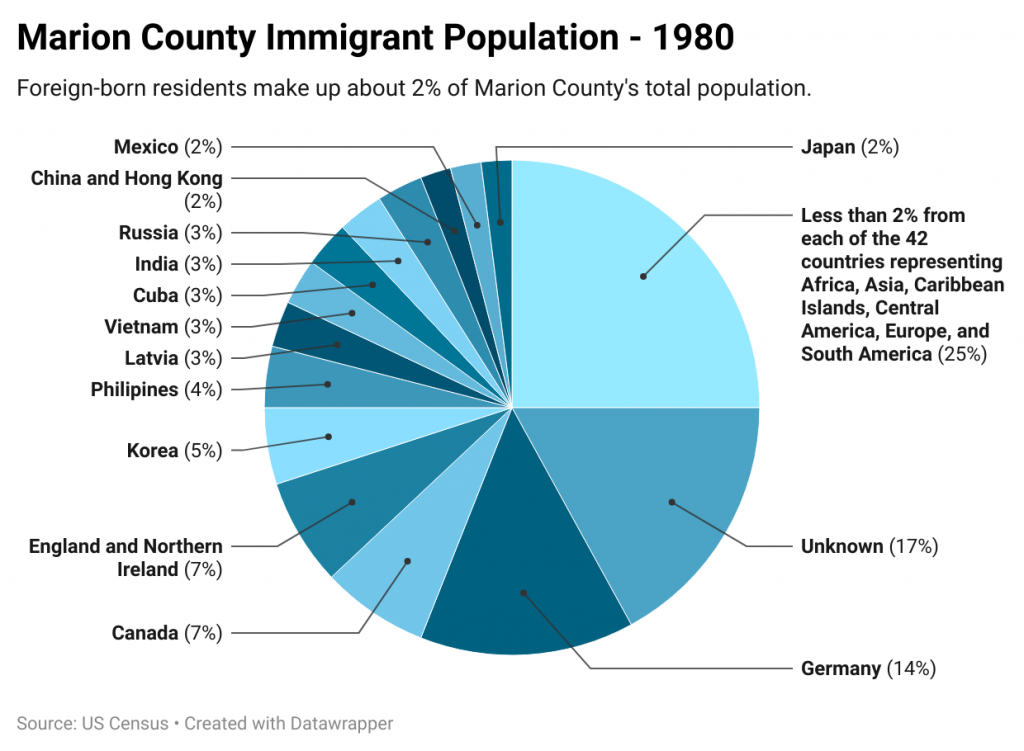
Fidel Castro announces that all Cubans wishing to emigrate to the U.S. may travel by boat from Mariel Harbor. The boatlift spans a six-month period, ending in October, and includes about 1,700 boats that deliver 125,000 Cuban refugees to American shores. Volunteers from several Indianapolis churches band together to resettle the Cuban refugees who arrive in the city.
The Korean Presbyterian Church of Indianapolis is organized. The church not only conducts services in Korean but also establishes a Korean school.
The nonprofit organization is established to serve the legal needs of Cuban refugees who arrive in Central Indiana following the 1980 Mariel boatlift. It becomes the largest resettlement agency in the state for refugees and displaced persons fleeing persecution.
Established as a nonprofit, the organization works to promote Hispanic businesses.
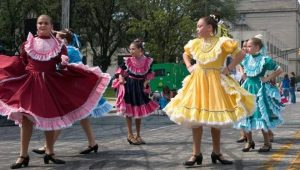
The first annual festival to celebrate the Latino community is a day-long event that takes place at Indiana World War Memorial Plaza. It becomes part of La Plaza, Inc. in 2004.
Credit: Jammy Straub, IndyStar View Source
The society houses the five department offices of its General Secretariat and several specialized organizations, with a focus on developing Muslim identity and supporting Muslim communities in North America.
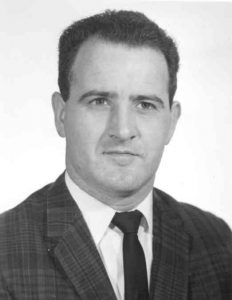
Born in Ireland, Conneally, a member of the IU School of Medicine faculty, goes on to be one of the researchers who map the actual Huntington’s Disease gene in 1993—the first human gene to be mapped using DNA techniques. He is recognized as a leader in human genetics.
Credit: Indiana University IndianapolisView Source
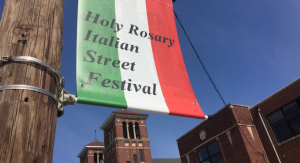
Holy Rosary Catholic Church revives the annual festival, first held in 1934, to celebrate the Italian heritage of its surrounding neighborhood.
Credit: Liz Biro, IndyStar View Source
With a rising Asian Indian population in Indianapolis, the center provides a place for organized social and cultural celebrations. The Indian community makes up 6 percent of the immigrant population of Indianapolis in 1990.

A group of Vietnamese Americans establishes the Chùa An Lḁc, or the An Lḁc temple, in two adjacent homes to have a space to practice its form of Buddhism.
Credit:Â Chad Bauman
U.S. Congress addresses the problem of unauthorized immigration by implementing a multi-pronged system that provides amnesty for established residents, increases border enforcement, enhances requirements of employers, and expands guestworker visa programs.
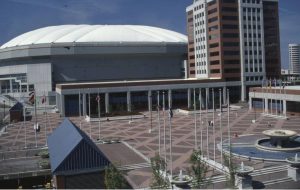
Indianapolis hosts the international sporting event for athletes from nations of the Americas which takes place between August 7-23.
Credit: Indiana Historical Society View Source
The organization explores issues in the Japan-U.S. relationship and presents a wide range of cultural events, networking receptions, and public affairs presentations.
Through the activism of the Jewish Federation, over 200 Soviet Jews settle in the city between 1989 and 1991.

The act revises the Immigration Act of 1965 by increasing the immigration allotment for the 1992-1994 fiscal years and adds visa categorizations: family-based immigration visa, employment-based visas, a diversity visa program, and the creation of a lottery for immigrants from “low admittance” countries or countries whose citizenry is underrepresented in the U.S.
The St. Stephens Bulgarian and SS. Constantine and Elena Romanian Orthodox churches partner with the St. Nicholas Serbian Orthodox Church to hold the festival that highlights the culture of these Balkan countries. St. Nicholas later sponsors the annual Serb Fest.

The school employs native speakers of French, Spanish, and Mandarin to establish its full language immersion programs. Fifty nationalities typically represent the International School’s student population.
Credit: International School of Indiana View Source
The Greater Indianapolis Progress Committee organizes the network that serves as a mechanism to foster positive relationships among the city’s diverse populations.
The organization unites Filipino Medical Technologists who reside in the state and works for the advancement of their common interests. The establishment of the Philippine Nurses Association of Indiana follows in 1999.
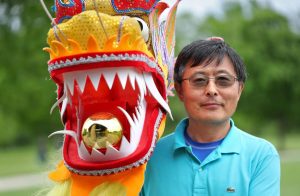
The community center organizes to provide Chinese families in Indianapolis a place for children to learn Chinese language and culture. Its mission includes teaching Chinese to non-Chinese-speaking families and to promote Chinese culture and heritage.
Credit: Kelly Wilkinson, IndyStar View Source

The festival showcases Irish culture as well as the contributions the country’s immigrants have made to Indianapolis.
Credit: Michelle Pemberton, IndyStar View Source
The organization enhances relationships between the Asian American community and the Central Indiana community at large.
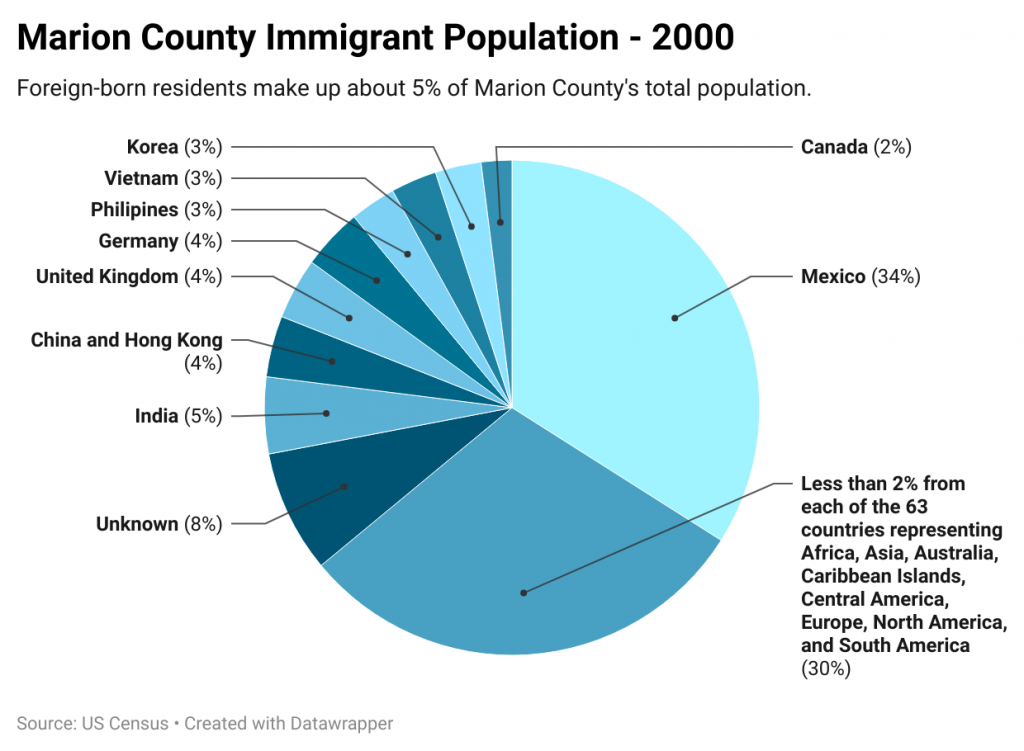
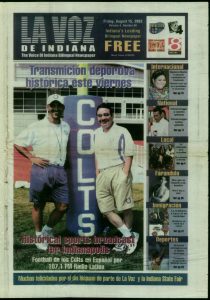
Liliana Hamnik, born and raised in Columbia, establishes the newspaper to educate and inform the city and state’s growing Latino community with her Spanish-language newspaper.
Credit: Indianapolis-Marion County Public Library View Source
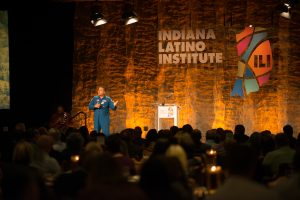
The Institute provides aid to organizations that serve the Latino community statewide. It first focuses on health-related programming but grows to address many important issues facing the Latino population, including education.
Credit: Marlene Dotson, Indiana Latino Institute, Inc.
Following the terrorist attacks of 9/11, leaders of the Muslim community create the Muslim Alliance to counter misinformation about members of the Muslim community, encourage civic engagement, establish interfaith alliances, and connect with intra-faith communities.

Al Huda Foundation is incorporated to serve Muslims in Fishers, Carmel, Noblesville, and northern portions of Indianapolis. It grows to become the largest congregation of Muslims in Indiana.
Credit: WFYI View Source

The consulate serves 80,000 Marion County residents of Mexican heritage. It focuses on aiding local residents in obtaining ID cards, passports, and visas among other services.
Credit: Robert Scheer via Imagn Content Services, LLC. View Source
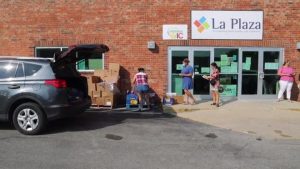
FIESTA Indianapolis, El Centro Hispano, and the Hispanic Education Center merge to become La Plaza, Inc.
Credit: Robert Scheer, IndyStar View Source
The organization is dedicated to improving the quality of life for Latino and immigrant families impacted by domestic and sexual violence.
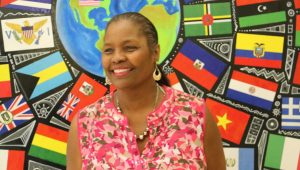
The community development corporation in the district, formerly known as the Lafayette Square neighborhood, organizes to highlight and encourage the growing and diverse number of Hispanic/Latino, African, Asian, and European businesses in the area.
Credit: Tim Swarens, IndyStar View Source
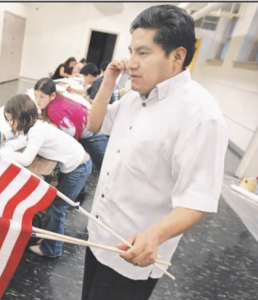
St. Mary’s Church becomes a focal point of support for Latino civil rights when Father Thomas Fox creates the coalition over concerns that lawmakers are moving to keep illegal immigrants from receiving public assistance and medical treatment.
Credit: Kelly Wilkinson, IndyStar View Source
The center, founded by volunteers, assists immigrants and refugees in getting the services and resources they need to settle in Indianapolis.
Approximately 15,000 people march in downtown Indianapolis to rally for immigration reform. Several national marches take place in various U.S. cities in the spring.
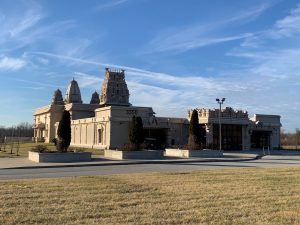
Created to serve the growing Hindu population, the Hindu Temple of Central Indiana is the first traditional Hindu temple in Indiana.
Credit: Chad M. Bauman
The organization provides resources and opportunities for Latino youth to engage in personal and community development, using critical thinking, grassroots organizing, and collective action.
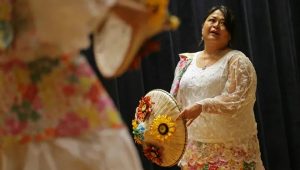
Hosted by the Asian American Alliance, Inc., Asian Fest celebrates the diverse Asian cultures of central Indiana.
Credit: Jenna Watson, IndyStar View Source
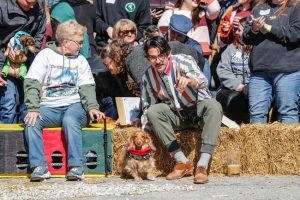
The festival, held at the Athenaeum, highlights the strong German heritage in Indianapolis and raises funds for the maintenance and care of the Athenaeum building.
Credit: Michelle Pemberton/IndyStar, Indianapolis Star via Imagn Content Services, LLC View Source
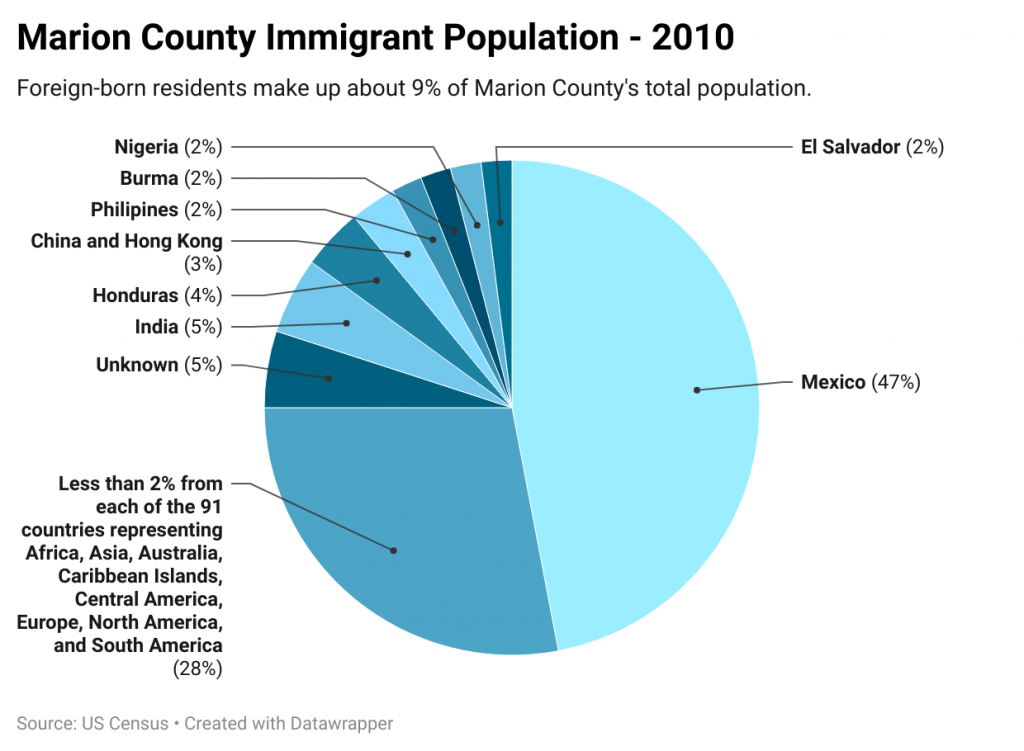
The institute supports Burmese newcomers to Indiana, who make up the largest number of immigrants from the region in the U.S. The highest concentration of the Burmese settle on the north and south sides of Indianapolis. Burmese immigrants make up 10 percent of the immigrant population of Indianapolis in 2020.
A protest to oppose House Bill 1402, which would deny undocumented students the lower tuition fees offered to in-state university students, takes place outside Governor Mitch Daniels’ office in the statehouse. The protests prompt formation of the Indiana Undocumented Youth Alliance, a youth-led organization that empowers undocumented youth to reach high levels of education and works to influence public policy and improve the quality of life of the undocumented in Indianapolis and Indiana.
The organization seeks to inspire cooperation among all religious and cultural groups to strengthen civil society.
The grassroots multicultural volunteer-operated organization is established with the goal of enhancing Latin-American art in the city.
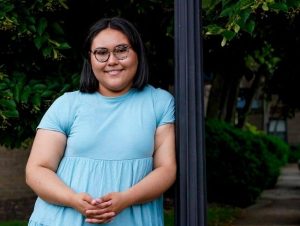
DACA provides temporary (renewable) legal protection to those who were brought to the United States as children. It also offers them work permits. This act does not provide a pathway to citizenship. The program is extended in 2014. The Indiana Undocumented Youth Alliance responds by establishing a scholarship fund for students with DACA status in addition to providing other financial and legal resources.
Credit: Michelle Pemberton/IndyStar / USA TODAY NETWORK View Source

NOPAL Cultural launches its first Dia de Muertos event at Studio B Gallery on Massachusetts Avenue. The organization begins its partnership with the Eiteljorg Museum for the event in 2014.
Credit: Doug McSchooler, IndyStar View Source
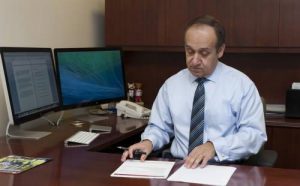
Paydar, an immigrant from Iran, becomes the fifth chancellor of IUPUI, as well as an executive vice president for Indiana University
Credit: Indiana University Indianapolis View Source
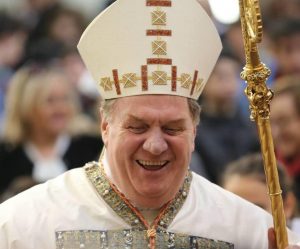
Although Gov. Pence halts state funding for resettlement of Syrian refugees, Tobin uses money available through Catholic Charities and resettles a Syrian refugee family in Indianapolis.
Credit: Adsderrick via Wikimedia Commons View Source
When the future of DACA becomes uncertain with the election of President Donald Trump, IUPUI students organize the group that provides support to undocumented students and directs them to academic, financial, and legal resources. It raises awareness about the issues facing the undocumented and creates a support system for them within the IUPUI and Indianapolis community.
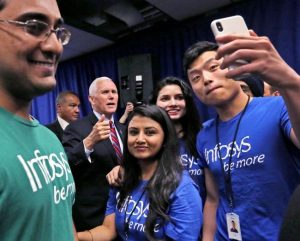
Infosys, an India-based global leader in technology services, begins construction of a new $245 million education center and residential facility on the site of the former Indianapolis International Airport terminal.
Credit: Kelly Wilkinson/IndyStar View Source
Arte Mexicano en Indiana organizes as a nonprofit that encourages and promotes Mexican art, music, and culture throughout the state.

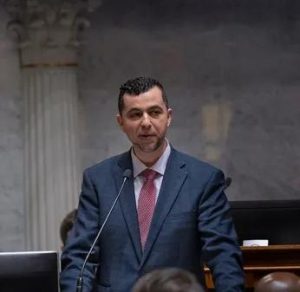
Indianapolis resident Fady Qaddoura is elected to represent the 30th district in the Indiana Senate, making him the first Arab Muslim lawmaker in the state’s history.
Credit: Kelly Wilkinson/IndyStar / USA TODAY NETWORK View Source
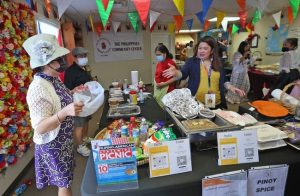
The center supports new Filipino immigrants to Indiana and works to educate people about Filipino culture. In 2020, Filipinos make up 2 percent of the immigrant population in Indianapolis.
Credit: Kelly Wilkinson/IndyStar via Imagn Content Services, LLC View Source
Following U.S. withdrawal from Afghanistan, 7,200 evacuees resettle at Camp Atterbury under a National Resettlement Act in 2014. About half stay to become Indiana residents.
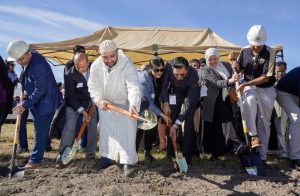
The Islamic Life Center, near West 141st Street and Shelborne Road, is the city’s first mosque. The Al Salam Foundation began the process to build the center in 2018. They were met with opposition from Carmel residents despite having the support of the city and religious leaders.
Credit: Grace Hollars/IndyStar / USA TODAY NETWORK View Source